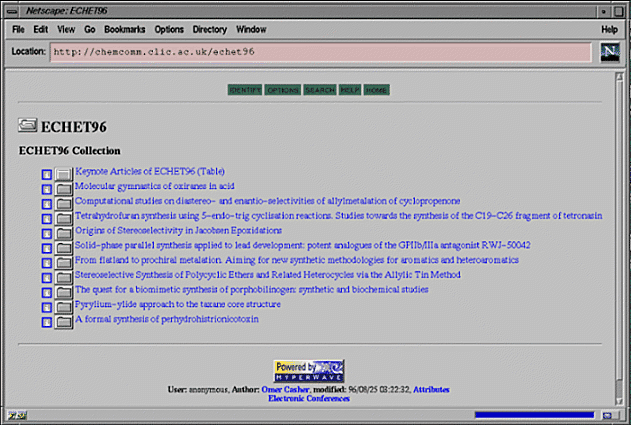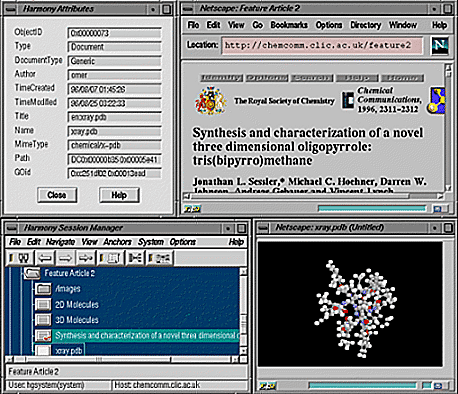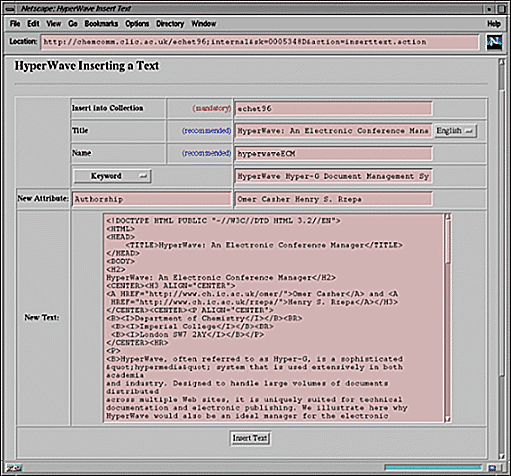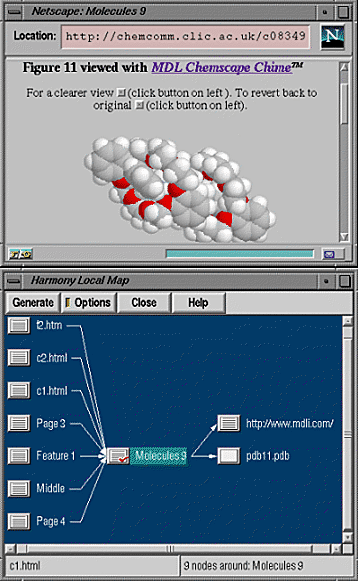| [Molecules: None] [Related articles/posters: None] |
HyperWave, often referred to as Hyper-G, is a sophisticated "hypermedia" system that is used extensively in both academia and industry. Designed to handle large volumes of documents distributed across multiple Web sites, it is uniquely suited for technical documentation and electronic publishing. We illustrate here why HyperWave would also be an ideal manager for the electronic conference. With careful planning HyperWave could be configured to run an entire electronic conference automatically. Moreover, its multi media support and recently developed applications could, in fact, propel the electronic conference into entirely novel domains.
The Molecular Hyperglossary [1], linkdb, and other in house packages were developed to assist in electronic conference management. Although they largely circumvented WWW Server limitations, it was clear that to fully address document management issues, an alternative to the WWW Server itself was needed. HyperWave's [2] potential for electronic conferences was clearly evident once we implemented it in an electronic journal [3]. Enhanced articles of Chemical Communication are now accessible on a HyperWave Server.

Figure 1: The collection of keynote articles
The indexing of documents permits rapid searching against title, keywords, name, or body. For now, only text in HTML or HyperWave's own HTF format are indexable against an appropriate DTD. Manuscripts submitted to the conference as HTML could therefore be inserted into the server by the author and indexed immediately. In the next release, indexing against user specified metadata will be possible. Each HyperWave document and collection has associated metadata (Fig. 2) and user defined metadata is permissable. Selected meta attributes could be indexed and individually searched. A filter is under development to index PostScript and filters for PDF, Microsoft Word and VRML documents are planned. User created filters for other document types, such as SGML with specialized DTDs, will also be possible.

Figure 2: The metadata of a PDB file
A variety of these filters would allow manuscript submission and modification in formats more familiar to the author. Documents would therefore need to be kept on the server in their native formats. The rendering of non HTML (or VRML for 3D models) in the client browser would likely require a suitable on-the-fly file conversion into HTML (or VRML). As both the HTML and VRML formats are evolving, creating these documents dynamically is advantageous. HyperWave's document cache server precludes the need for repetitive conversions.
In ECHET96, manuscript submission in HTML via a forms interface was encouraged. HyperWave has a similar document (Fig. 3) submission mechanism. In cases where submission of manuscripts, referee reports, or user comments by e-mail is more desirable, HyperWave's mail tool could be used to manage them appropriately.

Figure 3: Text insertion via a Netscape form
Document read and/or right accesses can be restricted to a single user or groups of users. A user can belong to more than one group. Time constraints can be set where a document can go "live" at a certain time and become inaccessible at a subsequent time.
Usually HyperWave administration is shared by a main administrator and trusted users who have read and perhaps write privileges for a subcollection of documents. In a conference setting, each author could be given a personal collection to add, remove and modify documents at will through a forms driven interface. In case of errors during modifications provisions to keep a replication of individual papers should be in place (see Conference Mirroring)
Harmony and Amadeus are being largely superseded by an HTML forms interface and a Java based client that promises to incorporate drag and drop features for document manipulation. This application has significant implications for the electronic conference. In the future, a conference could be coordinated through any Java aware Web browser. By this same means authors would be able to readily submit and organize the contents of their own papers. Furthermore, the complete conference can be browsed through a dynamically generated hierarchy tree running as a Java applet thereby precluding the need to maintain a table of contents.
As conference papers are often moved, removed, replaced or modified such link maintenance is vital; more so if the conference were spread over several sites with each site maintaining different documents. Of course the remote sites would have to each be running a HyperWave server, which might be superfluous for a site maintaining just its own conference paper.
Hyperlink maintenance is not restricted to HTML but also extends to PostScript, PDF, VRML, images, MPEG movies, and audio files. Conference papers, or even sessions, supplemented with voice and movie annotations can be envisioned.

Figure 4: All hyperlinks pointing to and from a PDB molecule
Document templates can also be used to construct tables or glossaries dynamically. Whenever a new paper is added related tables would be automatically appended with no human intervention. The table depicted (Fig. 5) could easily be constructed dynamically once the HyperWave server interrogates the meta attributes of each document in the Stereocontrolled Reaction collection.
Document templates also allow multiple document clustering where one HTML page is a composite of smaller documents. The reader would therefore have the choice of viewing a paper as one complete document or toggling through several smaller documents with the help of a glossary.

Figure 5: A typical table of conference papers
HyperWave is developing a mirroring daemon but its excellent document export and import tools do allow for fine tuning of site mirroring, albeit without instantaneous propagation of changes. This is achieved by querying the meta data of all documents in a specified collection and mirroring only those documents that match the query. Conference mirroring can, for example, be restricted to documents of individual papers or to documents created or modified after a certain date. Before a document at a mirror site is overwritten, various "safety checks" can be made such as assuring that the document is actually older than the one being mirrored. Mirroring can be configured to run automatically at specific times. For slow networks a timeout option permits up to five attempts at mirroring a document before moving on to the next one.
HyperWave has a standalone server component which, with the help of a HyperWave client, accesses a "local database" without connecting to a HyperWave server. As with a normal HyperWave database the local database contains indexed searchable documents. Because HyperWave documents are always assured of hyperlink consistency and HTML integrity, archiving an electronic conference as a local database on a CD-ROM is a highly efficient approach. HyperWave's CD tool is used for this purpose. A recently developed Java applet can be used to browse the documents as a tree hierarchy. A demonstration of this can be viewed here.
HyperWave is able to access an SQL database using its own gateway interface, HGI. A common gateway interface (CGI) request which initiates the execution of a program and its subsequent termination once the request has been processed, is ill-suited for a legacy database. Unlike CGI, HGI maintains a persistent connection to the database and does so tarnsparently. That is, an entire set of SQL queries could be organized as a collection hierarchy within a HyperWave Server each having its own meta data. Depositing and accessing structural information from a Web frowser to and from a database could therefore be made to appear totally seamless.